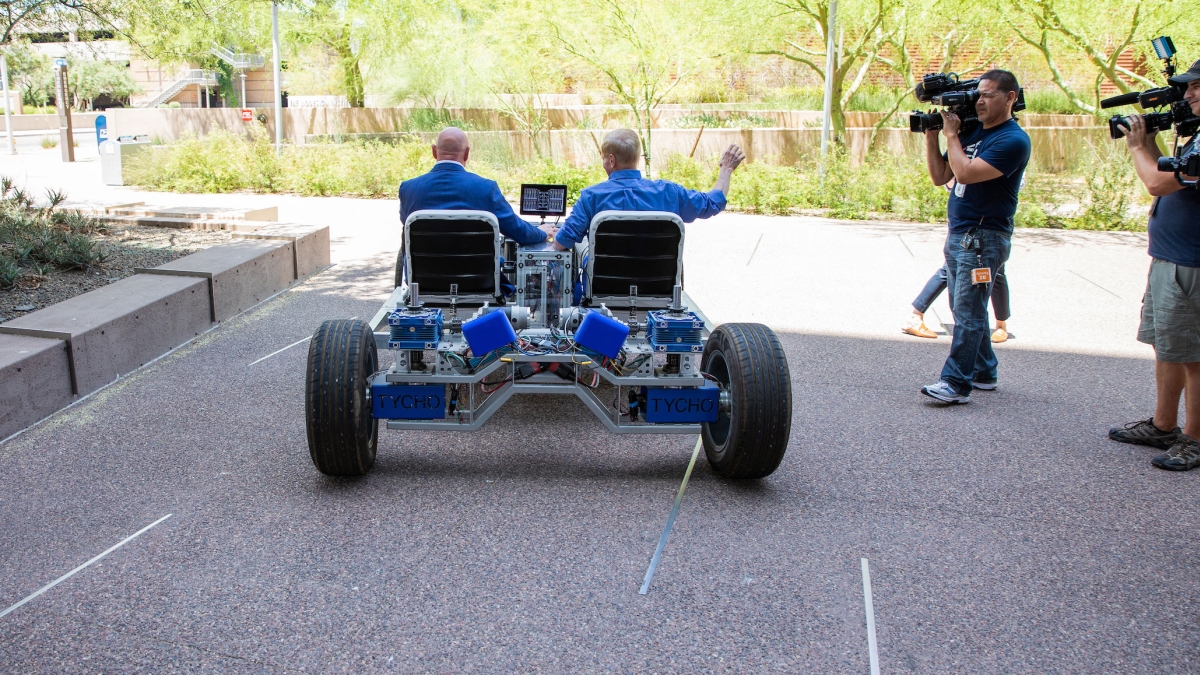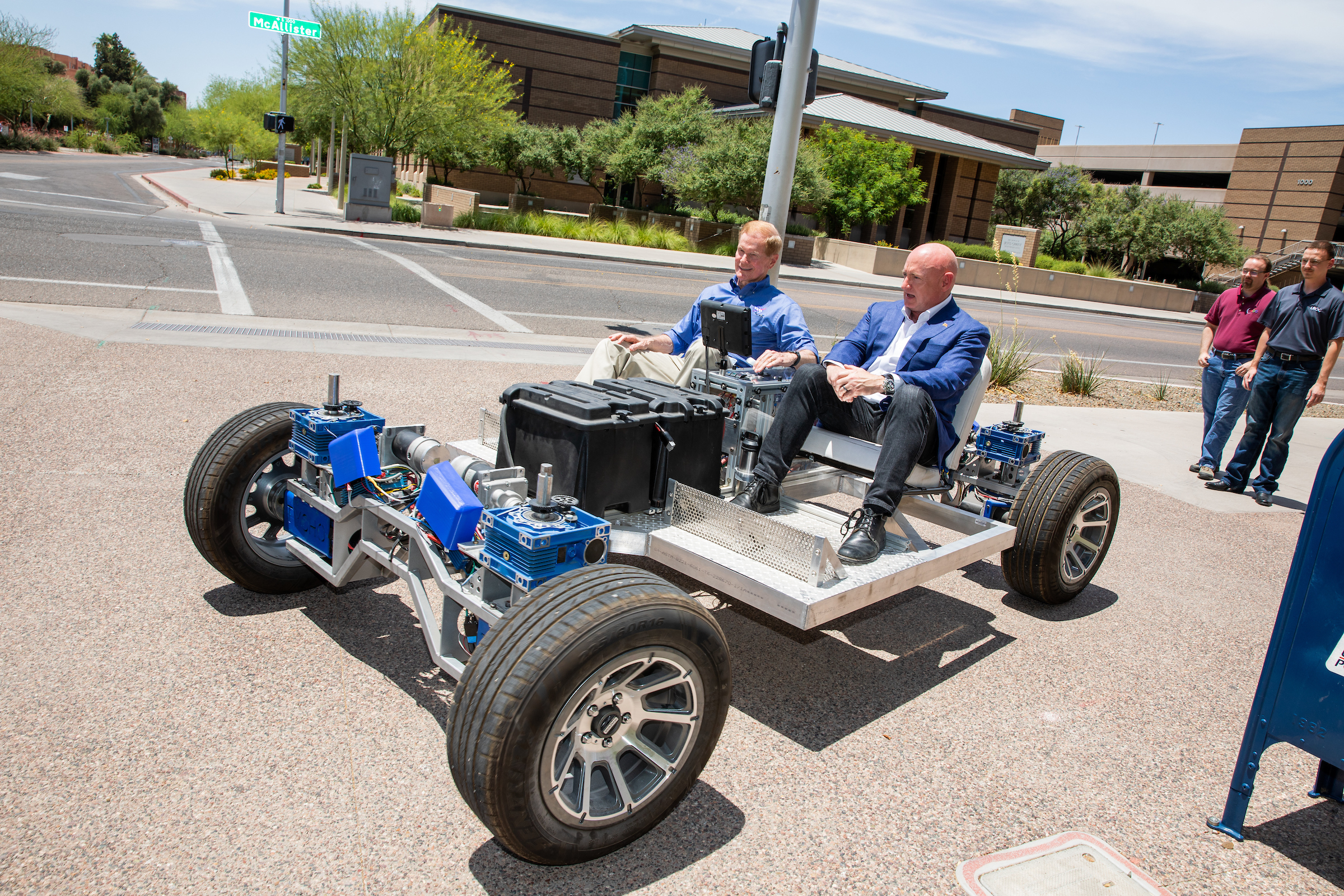Both men have been blasted into space and have served in the U.S. Senate. But NASA Administrator Bill Nelson and U.S. Sen. Mark Kelly were “back in school” during a visit to Arizona State University’s School of Earth and Space Exploration on Friday, May 27.
The pair got to see details of the university’s more than 20 space missions — ASU is leading the NASA space missions Psyche and LunaH-Map while also developing instruments for scientific missions to the moon, asteroids and planets, including the Lunar Reconnaissance Orbiter, OSIRIS-REx, Lucy and the Mars 2020 Perseverance rover. And it’s not just faculty; students take part in work both directly involved and inspired by these missions.
Among the hands-on lessons during Friday’s visit: strapping in for a ride on Tycho, a vehicle that can drive forward, backward and side to side. It can even spin itself a full 360 degrees around a single point. Tycho is a modern training vehicle designed and built to meet the needs of 21st-century human exploration of the moon and Mars. It was built by a team of staff and students at ASU.
“ASU is one of NASA’s premier universities as a partner. They build space hardware here,” says Kelly. “That’s pretty new. Universities typically don’t build the stuff that gets launched into space. They build the stuff here now instead of having some private or defense company do it. And that’s great for the students here. They’re going to leave here, and they’re going to be ready for these high-tech jobs of the future. We need more of that.”
NASA Administrator Bill Nelson (foreground) makes a comment during ASU Professor Mark Robinson’s (standing) presentation about Lunar Reconnaissance Orbiter Camera images and data during a tour of the various NASA projects in progress at ASU on May 27. Photo by Deanna Dent/ASU
Like Tycho, much of what the men saw Friday is directly connected to upcoming NASA goals and launches. Several of those missions involve the moon.
The Lunar Polar Hydrogen Mapper — LunaH-Map for short — is a CubeSat mission led by School of Earth and Space Exploration (SESE) Assistant Professor Craig Hardgrove. LunaH-Map, which will ride into space on the Artemis 1 rocket later this summer, is a miniaturized spacecraft about the size of a shoebox that will orbit the moon to map water-ice in permanently shadowed regions of the lunar south pole.
Professor Mark Robinson — who has been developing detailed maps of the moon for over 20 years as principal investigator for NASA’s Lunar Reconnaissance Orbiter Camera (LROC) — brought Nelson and Kelly up to date Friday on the next steps for LunaH-Map, whose discoveries could let scientists determine whether there’s enough water to support future human and robotic exploration of the solar system. Robinson also spoke about how LROC fits into some of the next steps for what NASA can do with robotic landers on the moon. NASA’s Artemis program aims to put humans back on the moon by the end of 2025.
Sen. Mark Kelly hams it up a bit while lifting a large meteorite sample in the Buseck Center for Meteorite Studies at ISTB4 on the Tempe campus May 27. Photo by Deanna Dent/ASU News
The visitors got the chance to tour the school’s Buseck Center for Meteorite Studies, which houses one of the world’s largest university-based meteorite collections.
Nelson says that for him, one the most vivid moments of the ASU visit was holding a chunky black diamond inside the center’s vault.
“And I’m telling you, if we ever find in quantities that can be harvested diamonds or titanium or gold or any other precious metals, can you imagine the amount of exploration? The California gold rush will just be a distant memory of what you'll see going on out in space,” he says.
NASA Administrator Bill Nelson holds up a meteorite at the center, which houses one of the world’s largest university-based meteorite collections. Photo by Deanna Dent/ASU
No diamonds are expected to come from samples to be collected by the Mars 2020 Perseverance rover. But when those samples do come to Earth, SESE Director Meenakshi Wadhwa will serve as Mars Sample Return program scientist to unravel the sample compositions.
Kelly and Nelson learned more about Mars inside SESE’s mission control room. This is where the Mastcam-Z camera team gathers images from Mars. That team is led by ASU Professor Jim Bell. The camera system onboard the Perseverance rover can zoom from wide angle to telephoto, take 3D images and video, and take photos in up to 11 unique colors. It’s part of the rover’s mission to document rock and sediment samples, search for signs of ancient microbial life and characterize the planet’s geology and climate.
No one’s sure exactly what NASA will find with the Psyche and Europa Clipper missions, which is why the agency is sending spacecraft to both places.
Sen. Mark Kelly speaks with ASU employees and students working in the Mission Operations for Lunar and Mars Sciences Laboratory during the May 27 tour of various NASA projects in progress at the School of Earth and Space Exploration. Photo by Deanna Dent/ASU
Psyche is a metal-rich asteroid orbiting the sun in the main asteroid belt between Mars and Jupiter. Psyche is also the name of the spacecraft which will go there, led by ASU Regents Professor Lindy Elkins-Tanton. The mission, which offers a unique window into the building blocks of planet formation, is scheduled to launch this fall. The Psyche team will investigate whether the asteroid is the core of an early planet and whether it formed in similar ways to the Earth’s core.
Europa is a moon of Jupiter, where an ASU-designed and -built thermal imaging instrument led by Regents Professor Phil Christensen is headed as part of the Europa Clipper spacecraft. The Europa Thermal Emission Imaging System (E-THEMIS) will scan temperatures across Europa’s surface, including regions where the moon’s presumed ocean may lie close to the surface. The Europa Clipper will make about 50 flybys of Europa to investigate whether the moon could harbor conditions suitable for life.
Associate Research Professor Cassie Bowman (fourth from right) and Psyche mission student interns talk about their outreach work and educational work during the May 27 tour at ISTB4. The Psyche spacecraft, the first ASU-led deep-space mission, is scheduled to launch this fall on its way to a metal-rich asteroid. Photo by Deanna Dent/ASU
Nelson says he likes that SESE combines students fresh to space work with experienced people at the top of their NASA careers.
“If I have anything to do with it, we are actually going to expand the internships, and a huge percentage of those interns come to work for NASA because they're so turned on to the work,” says Nelson. “It’s a rich source of extraordinary talent. As we move more and more into the commercial sector, that just all the more magnifies the use of universities, whether directly in a contract with NASA or through one of NASA’s commercial partners. I see this as a model for the future that's going to not only continue, it's going to grow.”
NASA Administrator Bill Nelson (left) and Sen. Mark Kelly take a test drive in Tycho, a lunar rover prototype built by a team of ASU students and researchers. Photo by Deanna Dent/ASU
Top photo: As numerous media members watch, Sen. Mark Kelly (seated, left) and NASA Administrator Bill Nelson take a test drive in Tycho, a lunar rover prototype that can drive forward, backward, sideways and with a tight turning radius during a tour of the various NASA projects in progress at ASU’s School of Earth and Space Exploration on May 27 on the Tempe campus. ASU researchers and students are involved in more than 20 space missions. Photo by Deanna Dent/ASU
More Science and technology
Large-scale study reveals true impact of ASU VR lab on science education
Students at Arizona State University love the Dreamscape Learn virtual reality biology experiences, and the intense engagement it creates is leading to higher grades and more persistence for biology…

ASU-led space telescope is ready to fly
The Star Planet Activity Research CubeSat, or SPARCS, a small space telescope that will monitor the flares and sunspot activity of low-mass stars, has now passed its pre-shipment review by NASA.…

ASU at the heart of the state's revitalized microelectronics industry
A stronger local economy, more reliable technology, and a future where our computers and devices do the impossible: that’s the transformation ASU is driving through its microelectronics research…








